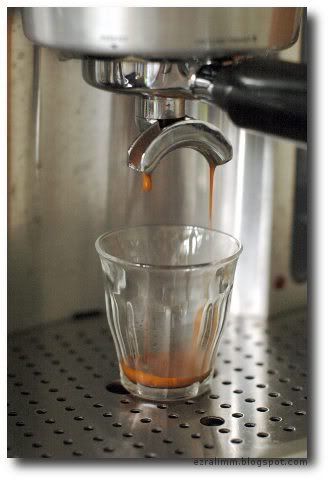 Espresso is a method of making coffee. A small amount of water (~30ml) is forced through about a heaped tablespoon of ground coffee. With just the right grind, good technique, fresh beans, and a decent machine, magic happens. The coffee flavours become infused into the water along with aromatic oils from the bean. An emulsion is created, and it drips down like syrup into the cup. Done right, this syrup will be well balanced. Done wrong, it will be sour and/or bitter and just terrible to drink. I am convinced that a great majority of people have never tasted a proper, well extracted espresso made with fresh beans as commercial establishments are simply not up to scratch. I have tasted some good espresso though, at family owned Italian restaurants that rely on repeat customers every morning. They are not as flash and spunky as the new Starbucks across the street, but they genuinely make good espresso, with a seasoned hairy chested italian guy (who actually drinks the coffee he makes) behind the counter instead of some random part time highschool kid.
Espresso is a method of making coffee. A small amount of water (~30ml) is forced through about a heaped tablespoon of ground coffee. With just the right grind, good technique, fresh beans, and a decent machine, magic happens. The coffee flavours become infused into the water along with aromatic oils from the bean. An emulsion is created, and it drips down like syrup into the cup. Done right, this syrup will be well balanced. Done wrong, it will be sour and/or bitter and just terrible to drink. I am convinced that a great majority of people have never tasted a proper, well extracted espresso made with fresh beans as commercial establishments are simply not up to scratch. I have tasted some good espresso though, at family owned Italian restaurants that rely on repeat customers every morning. They are not as flash and spunky as the new Starbucks across the street, but they genuinely make good espresso, with a seasoned hairy chested italian guy (who actually drinks the coffee he makes) behind the counter instead of some random part time highschool kid.Add steamed milk to it and you have a flat white. Add steamed milk with a bit of foam and it becomes a latte. Add steamed milk with lots of foam and it becomes a cappucino. Stir in some chocolate sauce before pouring in the milk and it becomes a mocha. Pour it straight onto icecream and it becomes an affogato.
When was the last time you ordered an espresso ('short black') or an americano ('long black') from Starbucks or Gloria Jean? Most commercial outlets make barely passable espresso that is then diluted with heaps of milk to mask the bad flavour! The average size of a latte in Italy, the birthplace of espresso is only about 160ml. Compare that to the smallest 300ml cup at Starbucks and you get the idea.
This mega blog post (months in the making!) is going to be all about Espresso and contains what I've learnt from two years trying to make the best espresso possible at home. I live in a small room on campus. If I can do it, so can you!
Contents:
TLDR: The Executive Summary
1) It's all about The Beans
2) The Grind
3) The Machine
4) The Art
5) Espresso Based Drinks
6) Getting Started (on the cheap)
7) Troubleshooting Guide With Pictures
Appendix: What is NOT an espresso machine.
Appendix: (under construction) Essential Accessories and Glassware.
Click below to read the full post:
The Executive Summary
You need beans that were roasted no longer than a month ago. Supermarket beans cannot be used to make espresso. A grinder that's designed for coffee will tear beans apart nicely instead of smashing them to dust. Capable grinders start at around $150. The best ones are around $1000. Only uniformly ground fresh coffee can make good espresso. Once ground, fresh coffee goes stale in less than 15 minutes! So called "espresso" machines at Target or Kmart are not espresso machines and are designed for stale supermarket pre-ground coffee. If the handle (portafilter) alone weighs less than half a kilo, it probably cant make espresso. A capable (out of the box) espresso machine starts at about $600 and weighs over 10kg dry. Good espresso machines cost at least $1500 and weigh over 15kg dry.
Good technique is required to make espresso. Extract properly and coffee will be flavourful with minimal bitterness and sourness. Extract too fast or use a machine that is not heated up properly and you'll get sour coffee. Extract too slow and you'll get bitter coffee. Extract unevenly and get varying degrees of sour and bitter. Dose-Level-Tamp-Extract technique must be consistent.
Steamed milk should never have visible bubbles and should appear glossy when held up to a light. It should be homogeneous (not separated with foam on top and liquid at the bottom) when being poured into the cup. It must never be overheated (scalded) as it affects the texture and sweetness of the milk. A good milk based coffee will not require much sugar, if any at all, as it is naturally sweet.
Note: The guide to getting started is further below.
1) It's All About The Beans
- A month after roasting, they are stale even with proper storage.
- Ground coffee goes stale in 10 minutes.
- Only fresh beans can generate the resistance required in the high pressure espresso method.
- You need to roast your own beans or order them online from specialty stores that roast on demand.
- Coffee beans are unbelievably cheap.
2) The Grind
- A burr grinder made for grinding coffee is the absolute minimum requirement for espresso.
- The grind determines the amount of resistance the coffee will give when put under high pressure.
- To fine, the extraction will be slow and the coffee will be bitter.
- Too coarse, water gushes through and you'll have sour coffee.
Cheaper grinders under AUD500 tend to generate clumps that cause uneven extractions. To overcome this, grind into a cup, agitate with a bamboo skewer or something thin, and then only dose into the portafilter.
3) The Machine
Please see the appendix for what is NOT an espresso machine.
- Cheapest machines that can make proper espresso? Google Rancilio Silvia, Sunbeam EM6910 and Lelit Combi.
- If the handle (portafilter) weighs less than half a kilo, chances are you're not looking at a proper espresso machine.
- Must have decent heat stability. Machines under 6kg are unlikely to be suitable for making real espresso.
That said, there have been a number of "domestic" espresso machines that are more affordable. They are more user friendly and cheaper, but do not offer the same sheer thermal stability as the bigger machines. Even then, they are still quite heavy, and as a general rule, their weight is reflected in their price. I personally own the lightest and cheapest of these. Its RRP is AUD800 but I picked one up on sale for only AUD550. It is the popular Sunbeam EM6910. Made in china, not Italy. Unapologeticly and obnoxiously loud, it weighs only 10kg dry. It is _the_ cheapest machine in the Australian market that could make decent espresso out of the box.
4) The Art
Now we get down to actually making the coffee. It's a ritual. It's an art. It starts half an hour in advance. Turn on your machine and loosely fit the handle in. Wait for it to warm up completely. Take just enough of your freshly roasted beans out of the air tight container you are storing it in. Grind it and make sure there are no clumps when it goes into the filter basket. The real art of making a good shot lies in how you grind and put the grounds into the filter basket. Level off the ground coffee with the back of a knife (or utensil of your choice), and tamp with a proper sized tamper. A proper dose-level-tamp technique will generate a nice even puck of coffee that generates the right resistance for espresso. It should take no longer than 30 seconds so that the portafilter does not cool down too much. If it does, you may want to fit the portafilter into the machine and wait a few minutes to come back up to temperature before making your shot.
Pouring espresso is simple. Turn the machine on, and wait for about 22-25 seconds. If the stars are aligned and angels smile upon you, roughly 30ml of a thick emulsion would have dripped out of the machine. If too much drips out (a "gusher"), your coffee will be sour. If too little drips out, you will have overextracted, bitter coffee by the time you hit 30ml. How often the stars align will depend on your skill as a barista, assuming you have fresh beans and capable tools for the job.
Foaming milk really takes practice to master. The whole idea is to spin and agitate the milk as fast as you can without making big bubbles! The milk must be as cold as possible to give yourself as much time to do this it as possible. First allow the steam tip to be just below the surface. This would suck in air into the milk and expand it. Then push it a little further below the surface and allow the turbulence to homogenize the milk by taking the bubbles on top and forcing it downwards into the vortex. If you are doing it right, your milk would turn into a homogenous microfoam. It's glossy and silky smooth. No visible bubbles. Yet the volume would have expanded appropriately. For this to happen you will need practice and avoid overheating the milk. This can be done by touch and experience. As a rough guide, once you can no longer touch the bottom of the pitcher for 2s, your milk is ready.
5) Espresso Based Drinks
A flat white, cappuccino, and latte are all the same. The only difference is the amount of foam in the cup. When left to stand, a cappucino should be 1/3rd foam, a latte should have about a thumb's breadth of foam on the top, while a flat white should have almost no foam or just a thin foam cap less than 5mm on top. The volume of the foam is determined during steaming by varying the amount of air sucked into the milk during the initial foaming process. The smooth milk is then poured into the cup and served BEFORE it separates. If you see a layer of foam on top before serving you are probably doing it wrong! The milk and the coffee should be one nice homogenous mixture when it is served. Pour it in front of your guests if you have to (This will impress most people who have not seen latte art!). The first few mouthfuls from a properly made cappuccino are divine as the milk had not yet separated to foam and liquid. It's like drinking a thick viscous foam.
Personally, I give my guests half a teaspoon of sugar with each milk based drink by default. I add the sugar to the milk before foaming. If you had made your espresso correctly, nobody will ever ask for extra sugar as your coffee will neither be bitter or sour. Flavourful, savory and milky sweet. A small meal by itself. A well made milk based drink.
A macchiato is simply an espresso with a little steamed milk. It means "marked" in italian. Roughly double the volume of your espresso shot, and use a teaspoon to mark the top with a dot of white microfoam.
A ristretto shot is an espresso that is made with even less water than usualy. Instead of 30ml in 25 seconds, aim for 20ml in the same amount of time. Do this by making your grind a little finer than usual. Some people mess with varying their dose, but seriously, it will screw up your consistency between shots and is quite impractical. Ristrettos really drip like honey and are very very tasty. Make a 40ml ristretto with a double basket (~20g coffee) in the same amount of time if the single basket holds too little coffee for you.
Espresso con panna is just simple espresso topped with whipped cream.
An affogato is vanilla ice cream topped with espresso. Traditionally, it's a scoop of ice cream with espresso poured directly on top. I find that most people (non espresso drinkers) will find this too strong. To make it more palatable, pour the shot separately, skim off the crema, and just scoop the potent black liquid on top of ice cream as desired. The coffee taste will still be more intense (with almost no bitterness) than the most intense coffee ice cream you can buy. You can also experiment with toppings like sticky date pudding, raisins, and other things that go well with the vanilla and coffee flavour profile.
6) Getting Started
- Fresh coffee roasted no longer than a week ago.
- The best grinder you can afford.
- A decent espresso machine.
Good coffee roasted fresh and couriered to you on demand is expensive, as in AUD40 (RM120) per kilo plus postage (around $10) expensive. Smaller packs of quality beans from reputable roasters (assuming you live close to one) sell for about AUD15 for 0.250kg. Green coffee beans can be obtained for only AUD10 per kilo if you know where to look. Andy, a coffee enthusiast from coffeesnobs.com.au sells them at very reasonable prices to members. A shot of espresso uses about 10g of roasted beans (around 8g really, but some beans need to be sacrificed...more on that later). Once roasted the beans are lighter, but you are still left with about 800g. That's 80 shots of espresso made with only AUD10 worth of beans. Yup, it costs less than 15 cents worth of coffee for each espresso made. This unbeatable value means that you'll find yourself experimenting and playing around, improving your technique, and offering free coffees to your friends!
So you find yourself roasting coffee. In the past, domestic roasting machines cost upwards of AUD1000 (RM3000). But last year a domestic machine (the behmor) was introduced that is only AUD400. But even that isnt quite cheap enough for the student who has yet to earn a dime. I roast my coffee in a popcorn machine. It's just coincidence that coffee roasts at the same temperature that popcorn pops, and it's not an ideal way to roast coffee (it roasts too quickly!), but for 50 bucks (RM150) im not complaining. Fresh coffee will taste heaps better than the most expensive coffees you could buy in the supermarket.
Some coffee enthusiasts spend more on buying good grinders than they do on their espresso machine. These grinders go for upwards of AUD1500. Not everyone has that kind of money lying around. The italians have been making domestic espresso-quality grinders for some time, but even then they are still relatively pricey, with models starting from around AUD500 (RM1.5k). Then Sunbeam came along, and introduced what was effectively a clone (licensed copy?) of a popular italian home grinder. The EM0480 made in china but uses the same grinding mechanism as the Nemox Lux. At under AUD200, it's a steal, and it remains the cheapest grinder capable of grinding beans for espresso. It's not a good grinder by espresso standards, but it is definitely capable (it was built from the ground up to grind for espresso). Reasonable build quality and a brushed metal finish makes it a very attractive buy.
I am using a cheap made-in-china Sunbeam EM6910 that I picked up for only AUD550 (RRP799) last year. The closest competitor, an Italian made 11kg Rancillio Silvia, costs upwards of AUD800 even after bargaining, and has far fewer user friendly features, although it is arguably a lot more reliable and has been in production for many years. Even though the EM6910 is a cheap machine, it has all the fundamentals needed to make decent espresso. It generates enough pressure, and has a sizeable chunk of brass to maintain thermal stability. It uses a standard 58mm coffee basket and the handle (portafilter) weighs about half a kilo. Bottom line:
- The Rancilio Silvia is more traditional and can produce better coffee (if you are very patient), but is less user friendly. Better built and more reliable.
- The Sunbeam EM6910 was designed in the 21st century and can make coffee and steam milk simultaneously. It has all these really helpful features like it goes off by itself if left turned on which is a good thing because espresso machines run HOT!
- The Lelit Combi has terrific value. It's a grinder and espresso machine built into one device. But anyone serious enough to read this far into this post about coffee would likely be upgrading their grinder before anything else. So I do not recommend it.
7) Troubleshooting
It is almost certain that the first few months of making coffee will be frustrating so I am going to include this simple troubleshooting guide. It assumes you have fresh beans and capable equipment.
Is you dosing and levelling technique good enough? Yes it has to be THAT evenly distributed. Wet clumps with less dense areas will kill your shot as high flow channels will form (making your coffee sour)
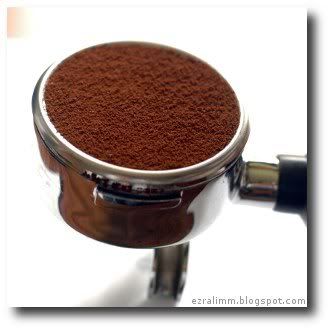
Note how level the tamp is. A proper dose and tamp is essential.
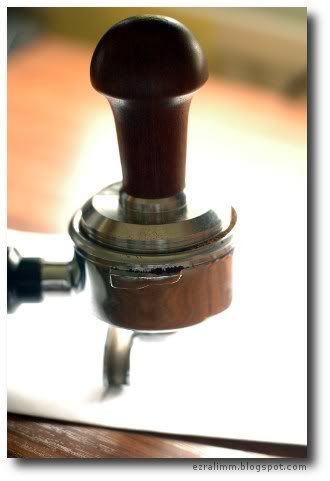 After extracting your coffee (first pic in this blog post), examine the portafilter. It should be as seen in the picture below. I used no updosing, it was done with fresh beans and a good single dose-level-tamp technique. There should be no signs of channeling ("holes" or "wet spots") in the basket and you should see an imprint of the showerscreen on the coffee surface. Proper fresh coffee expands a little when exposed to water and that is why you get this effect. WARNING: Forcing stale coffee to have an imprint of the showerscreen WILL damage your machine as you will have to updose and there is a real risk of pressing your showerscreen with the overloaded basket.
After extracting your coffee (first pic in this blog post), examine the portafilter. It should be as seen in the picture below. I used no updosing, it was done with fresh beans and a good single dose-level-tamp technique. There should be no signs of channeling ("holes" or "wet spots") in the basket and you should see an imprint of the showerscreen on the coffee surface. Proper fresh coffee expands a little when exposed to water and that is why you get this effect. WARNING: Forcing stale coffee to have an imprint of the showerscreen WILL damage your machine as you will have to updose and there is a real risk of pressing your showerscreen with the overloaded basket.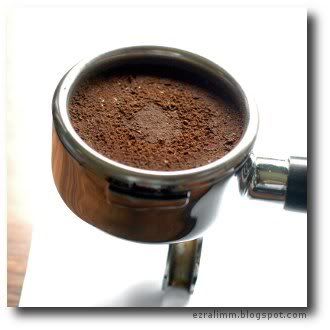
If you have done everything right, the puck should pop out easily into your knockbox. It should not be cracked. No wet spots. No signs of cracks or water seeping down the sides past the coffee. Just a nice, even puck.
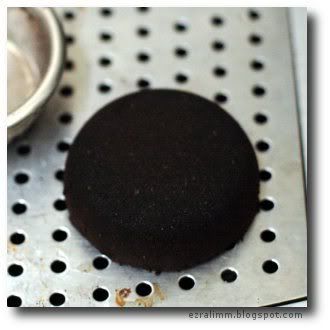
Appendix: What Is NOT an Espresso Machine
- Almost every "espresso" machine you see at consumer homeware stores like Target or Kmart. They dont make espresso...at least before modification.
- All machines under AUD500 are designed for stale, pre-ground, supermarket coffee.
- It is possible to modify these cheaper machines to make what would pass off as espresso, but you'll need a grinder and roast to order beans (or home-roast). The minor modification can be found online if you look hard enough.
As a rule, almost every coffee maker you see out there for under AUD500 (RM1500) is not an espresso machine. The cheap boiler ones are glorified moka pots. The more expensive AUD150-500 ones have a small high pressure micropump. Im not saying they are scams or that they are bad. I am saying you cannot make espresso with these machines. They use the term "espresso" on the box to woo customers into buying them. Stale coffee cannot be used to make espresso because water just gushes through it like water on sand - yet that is what people buy in supermarkets. The micropump based machines squeeze the coffee through a single small pinhole to make a foamy liquid that somewhat resembles espresso. It's not espresso. Real espresso is extracted slowly with minimal water from the resistance that comes from fresh roasted ground beans.
Again, I highlight the importance of fresh coffee beans that are grinded on demand. It is possible to buy a small micropump based machine for say AUD200 and make espresso, but to do so involves some modifications, namely the replacement of the pinhole mechanism. Some specialty stores do sell them. They are called "Unpressurized filter baskets". All real espresso baskets are unpressurised. (But the industry standard is 58mm. These cheap machines use the Chinese standard, which is 51mm). A suitably sized unpressurized basket can be hard to find, but look hard enough and you will find them online. They often cost AUD20 or more for what is effectively a simple piece of metal due to their rarity. You will find it impossible to use supermarket coffee with an unpressurized, proper espresso filter basket. Water just gushes through. So you will need to spend on fresh beans and a grinder as well. Now do you see why the makers of these cheap machines assume you will just use stale beans? Because most consumers who buy these cheap machines will never invest in a grinder, much less a roaster, or fresh AUD40/kg roast to order beans. And even when you do have those things, you'll have serious issues with temperature stability that make your coffee really sour really often. At the end of the day, it is possible to create what would pass off as espresso with these cheap machines (post-modification) and we shouldnt dismiss them entirely. The quality of the espresso however will be sorely lacking even with a grinder and fresh beans.
Thanks for your home espresso guide Ezra. I am a newbie and really appreciated your frank advice re which is a good machine for first time espresso maker at home. I also didn't know about the importance of the quality of grinder. How can I find out about a local coffee bean seller who has reliably fresh beans without ordering the roast to order variety you mentioned?
ReplyDeleteGreat post mate. Not too short, not too long, and a great starting place for a beginner. I've now gotten a new basket and a grinder, and with a kilo of beans and a few late nights, I'm finally getting somewhere!
ReplyDeleteCheers,
Steve.
That's a great guide Ezra.
ReplyDelete(Time to look for a publisher?)
PS I'm sorry.. I noticed a couple more spelling errors (I promise I wasn't looking for them)
"A ristretto shot is an espresso that is made with even less water than usualy."
"and we shouldnt dismiss them entirely" (second last sentence, apostrophe in 'shouldn't')
-Scott :)
Thanks for the compliments guys :)
ReplyDeleteDo note that this article is due for review. There are some very big changes that need to be made. Firstly, there are more machines within the sub $800 price bracket that DO make espresso out of the box. Secondly, the troubleshooting guide is rendered pointless by current dosing techniques: namely the Weiss Distribution Technique + NSEW tamp. I no longer level before tamping and I measure beans by volume (shotglass!). It is very very consistent, reliable, FAST, and puts the methods described in the article to pasture.
Scott, thanks for pointing out the mistakes... I will correct them when I update this article.
Oh and btw, if you are looking for fresh beans, your best bet is a coffee place that roasts on-site. There are many small gourmet roasters that roast on-site. They will even tell you the date of the roast if you ask.
ReplyDeleteAlternatively, order some from beanbay.coffeesnobs.com.au ...
Great effort. You are right about getting the perfect resistance to make great espresso. I have 'stolen' your photo and linked to your blog from here ... http://www.quora.com/Espresso/How-can-an-espresso-hobbyist-diagnose-the-problem-when-they-taste-something-amiss-in-their-coffee
ReplyDeleteThis comment has been removed by a blog administrator.
ReplyDeleteThis comment has been removed by a blog administrator.
ReplyDeleteHow do you roast with a popcorn maker?
ReplyDeletePeter, feel free to use the photo as long as it's credited :)
ReplyDeleteAnon (Dec 2), your answer comes from the oracle. Behold! : THE ORACLE HAS SPOKEN
your blog Provides nice about the coffee are helps me to find my detail. your blog is very good for me please keep it up.I like it
ReplyDeleteVisit :- Best Espresso Machine
Anyone get a good knowledge at Home Espresso after read the whole article who are coffee enthusiast. Thanks for sharing this information.Love to see this post in this Coffee Guide Blog. Waiting for the next post.
ReplyDelete